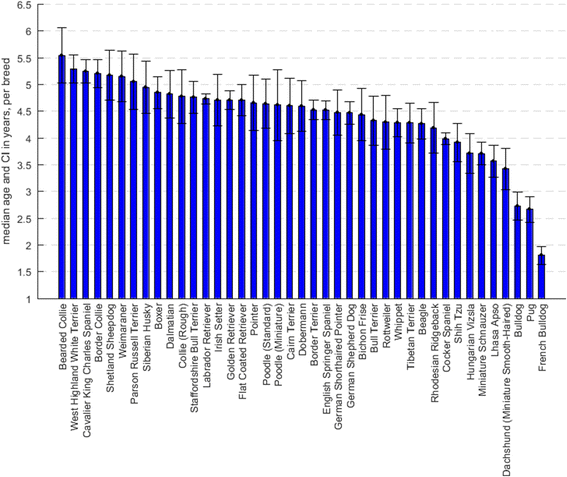Large-scale survey to estimate the prevalence of disorders for 192 Kennel Club registered breeds
- PMID: 28932406
- PMCID: PMC5604186
- DOI: 10.1186/s40575-017-0047-3
Large-scale survey to estimate the prevalence of disorders for 192 Kennel Club registered breeds
Abstract
Background: Pedigree or purebred dogs are often stated to have high prevalence of disorders which are commonly assumed to be a consequence of inbreeding and selection for exaggerated features. However, few studies empirically report and rank the prevalence of disorders across breeds although such data are of critical importance in the prioritisation of multiple health concerns, and to provide a baseline against which to explore changes over time. This paper reports an owner survey that gathered disorder information on Kennel Club registered pedigree dogs, regardless of whether these disorders received veterinary care. This study aimed to determine the prevalence of disorders among pedigree dogs overall and, where possible, determine any variation among breeds.
Results: This study included morbidity data on 43,005 live dogs registered with the Kennel Club. Just under two thirds of live dogs had no reported diseases/conditions. The most prevalent diseases/conditions overall were lipoma (4.3%; 95% confidence interval 4.13-4.52%), skin (cutaneous) cyst (3.1%; 2.94-3.27%) and hypersensitivity (allergic) skin disorder (2.7%; 2.52-2.82%). For the most common disorders in the most represented breeds, 90 significant differences between the within breed prevalence and the overall prevalence are reported.
Conclusion: The results from this study have added vital epidemiological data on disorders in UK dogs. It is anticipated that these results will contribute to the forthcoming Breed Health & Conservation Plans, a Kennel Club initiative aiming to assist in the identification and prioritisation of breeding selection objectives for health and provide advice to breeders/owners regarding steps that may be taken to minimise the risk of the disease/disorders. Future breed-specific studies are recommended to report more precise prevalence estimates within more breeds.
Keywords: Breeds; Dogs; Morbidity; Pedigree; Prevalence; Survey.
Conflict of interest statement
Ethics approval and consent to participate
Participants consented to the data provided on dogs being used for the purposes of research according to the Kennel Club’s Privacy policy:
Consent for publication
Not applicable.
Competing interests
BW, KE and TL are employed by the Kennel Club. AL-Z was employed by the Kennel Club and KE was employed by the University of Nottingham School of Veterinary Medicine and Science at the time the study was undertaken. DON was funded at the RVC by an award from the KCCT.
Publisher’s Note
Springer Nature remains neutral with regard to jurisdictional claims in published maps and institutional affiliations.
Figures


References
-
- Wayne RK, Leonard JA, Vila C. Genetic analysis of dog domestication. In: Zeder MA, editor. Documenting domestication: new genetic and archaeological paradigms. Berkeley: University of California Press; 2006. pp. 279–293.
-
- Bateson P. Independent inquiry into dog breeding. Cambridge: University of Cambridge; 2010.
-
- Rooney N, Sargan D. Pedigree dog breeding in the UK: a major welfare concern. Hosham UK: Royal Society for the Prevention of Cruelty to Animals; 2009.
LinkOut - more resources
Full Text Sources
Other Literature Sources

